2020 NISSAN 370Z seat adjustment
[x] Cancel search: seat adjustmentPage 7 of 455

Illustrated table of contents0
Safety — Seats, seat belts and supplemental restraint
system1
Instruments and controls
Pre-driving checks and adjustments
Center display, heater, air conditioner, audio, phone and
voice recognition systems
Starting and driving
In case of emergency
Appearance and care
Do-it-yourself
Maintenance and schedules
Technical and consumer information
2
3
4
5
6
7
8
9
10
Table of
Contents
Index11
Page 24 of 455
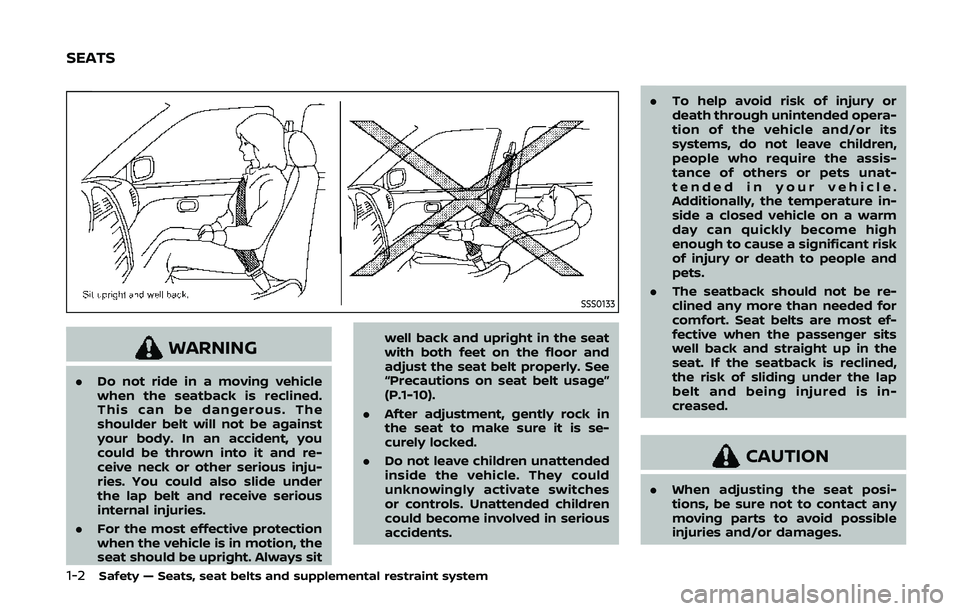
1-2Safety — Seats, seat belts and supplemental restraint system
SSS0133
WARNING
.Do not ride in a moving vehicle
when the seatback is reclined.
This can be dangerous. The
shoulder belt will not be against
your body. In an accident, you
could be thrown into it and re-
ceive neck or other serious inju-
ries. You could also slide under
the lap belt and receive serious
internal injuries.
. For the most effective protection
when the vehicle is in motion, the
seat should be upright. Always sit well back and upright in the seat
with both feet on the floor and
adjust the seat belt properly. See
“Precautions on seat belt usage”
(P.1-10).
. After adjustment, gently rock in
the seat to make sure it is se-
curely locked.
. Do not leave children unattended
inside the vehicle. They could
unknowingly activate switches
or controls. Unattended children
could become involved in serious
accidents. .
To help avoid risk of injury or
death through unintended opera-
tion of the vehicle and/or its
systems, do not leave children,
people who require the assis-
tance of others or pets unat-
tended in your vehicle.
Additionally, the temperature in-
side a closed vehicle on a warm
day can quickly become high
enough to cause a significant risk
of injury or death to people and
pets.
. The seatback should not be re-
clined any more than needed for
comfort. Seat belts are most ef-
fective when the passenger sits
well back and straight up in the
seat. If the seatback is reclined,
the risk of sliding under the lap
belt and being injured is in-
creased.
CAUTION
.When adjusting the seat posi-
tions, be sure not to contact any
moving parts to avoid possible
injuries and/or damages.
SEATS
Page 25 of 455

FRONT SEATS
Front power seat adjustment
Operating tips:
.The power seat motor has an auto-
reset overload protection circuit. If the
motor stops during operation, wait 30
seconds, then reactivate the switch.
. Do not operate the power seat switch
for a long period of time when the
engine is off. This will discharge the
battery.
SSS0928
Forward and backward (if so equipped):
Moving the switch
forward or back-
ward will slide the seat forward or back-
ward to the desired position.
Reclining (if so equipped):
Move the recline switch
backward until
the desired angle is obtained. To bring the
seatback forward again, move the switch
forward.
The reclining feature allows adjustment
of the seatback for occupants of different
sizes for added comfort and to help
obtain proper seat belt fit. (See “Precau-
tions on seat belt usage” (P.1-10).) The
seatback may also be reclined to allow occupants to rest when the vehicle is
stopped and the transmission is in the P
(Park) position or N (Neutral) position with
the parking brake fully applied.
Safety — Seats, seat belts and supplemental restraint system1-3
Page 26 of 455
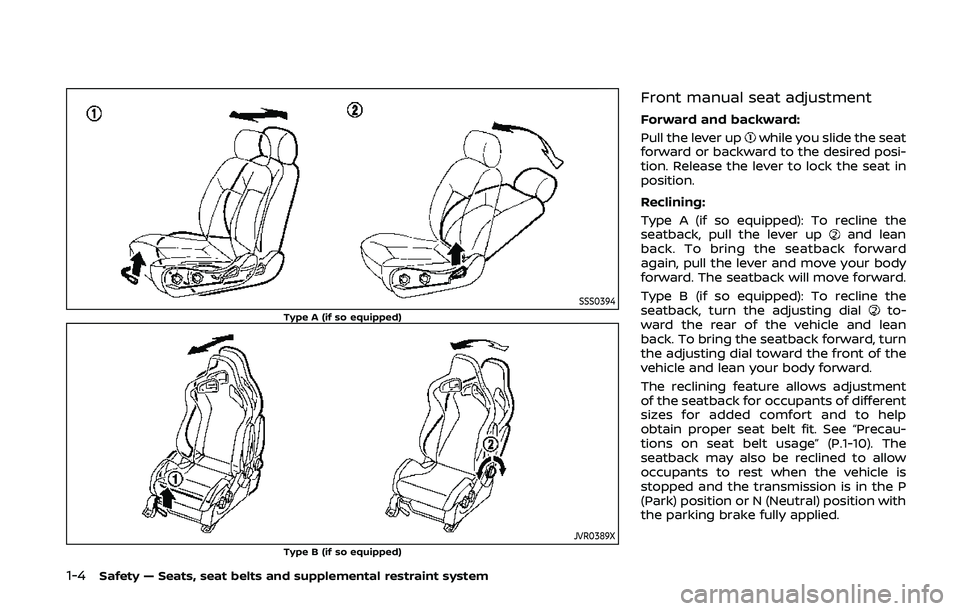
1-4Safety — Seats, seat belts and supplemental restraint system
SSS0394Type A (if so equipped)
JVR0389XType B (if so equipped)
Front manual seat adjustment
Forward and backward:
Pull the lever up
while you slide the seat
forward or backward to the desired posi-
tion. Release the lever to lock the seat in
position.
Reclining:
Type A (if so equipped): To recline the
seatback, pull the lever up
and lean
back. To bring the seatback forward
again, pull the lever and move your body
forward. The seatback will move forward.
Type B (if so equipped): To recline the
seatback, turn the adjusting dial
to-
ward the rear of the vehicle and lean
back. To bring the seatback forward, turn
the adjusting dial toward the front of the
vehicle and lean your body forward.
The reclining feature allows adjustment
of the seatback for occupants of different
sizes for added comfort and to help
obtain proper seat belt fit. See “Precau-
tions on seat belt usage” (P.1-10). The
seatback may also be reclined to allow
occupants to rest when the vehicle is
stopped and the transmission is in the P
(Park) position or N (Neutral) position with
the parking brake fully applied.
Page 28 of 455
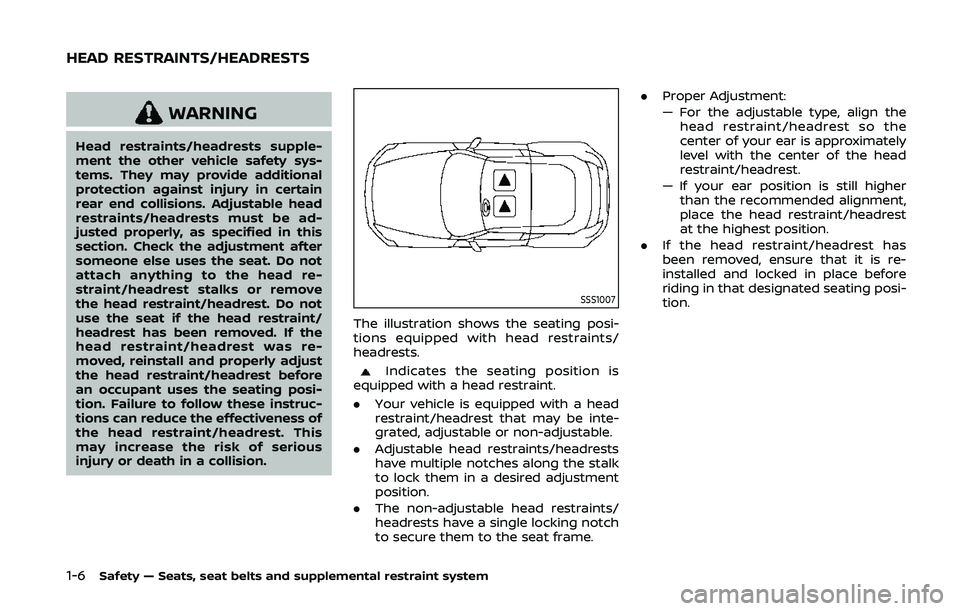
1-6Safety — Seats, seat belts and supplemental restraint system
WARNING
Head restraints/headrests supple-
ment the other vehicle safety sys-
tems. They may provide additional
protection against injury in certain
rear end collisions. Adjustable head
restraints/headrests must be ad-
justed properly, as specified in this
section. Check the adjustment after
someone else uses the seat. Do not
attach anything to the head re-
straint/headrest stalks or remove
the head restraint/headrest. Do not
use the seat if the head restraint/
headrest has been removed. If the
head restraint/headrest was re-
moved, reinstall and properly adjust
the head restraint/headrest before
an occupant uses the seating posi-
tion. Failure to follow these instruc-
tions can reduce the effectiveness of
the head restraint/headrest. This
may increase the risk of serious
injury or death in a collision.
SSS1007
The illustration shows the seating posi-
tions equipped with head restraints/
headrests.
Indicates the seating position is
equipped with a head restraint.
. Your vehicle is equipped with a head
restraint/headrest that may be inte-
grated, adjustable or non-adjustable.
. Adjustable head restraints/headrests
have multiple notches along the stalk
to lock them in a desired adjustment
position.
. The non-adjustable head restraints/
headrests have a single locking notch
to secure them to the seat frame. .
Proper Adjustment:
— For the adjustable type, align the
head restraint/headrest so the
center of your ear is approximately
level with the center of the head
restraint/headrest.
— If your ear position is still higher than the recommended alignment,
place the head restraint/headrest
at the highest position.
. If the head restraint/headrest has
been removed, ensure that it is re-
installed and locked in place before
riding in that designated seating posi-
tion.
HEAD RESTRAINTS/HEADRESTS
Page 29 of 455
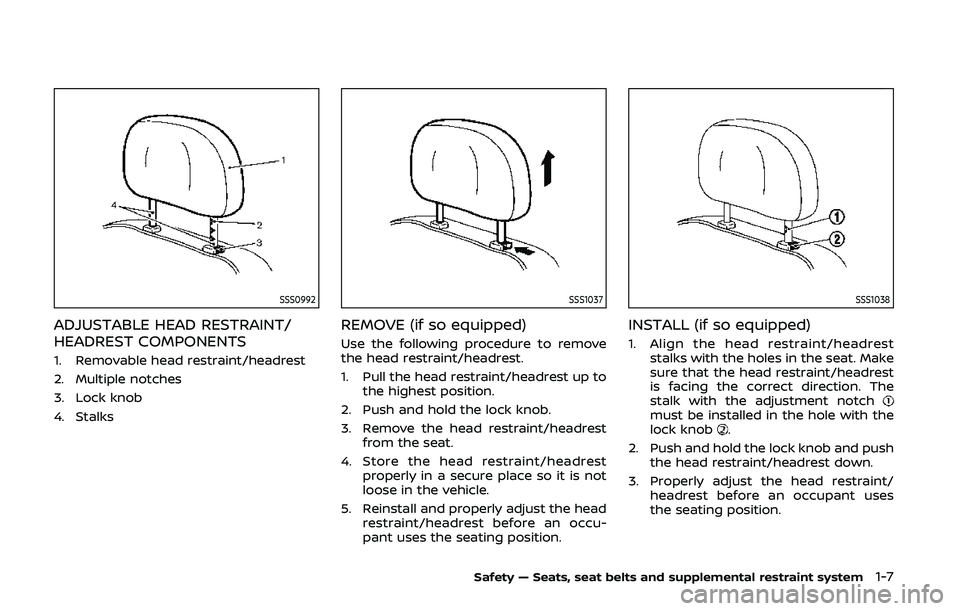
SSS0992
ADJUSTABLE HEAD RESTRAINT/
HEADREST COMPONENTS
1. Removable head restraint/headrest
2. Multiple notches
3. Lock knob
4. Stalks
SSS1037
REMOVE (if so equipped)
Use the following procedure to remove
the head restraint/headrest.
1. Pull the head restraint/headrest up tothe highest position.
2. Push and hold the lock knob.
3. Remove the head restraint/headrest from the seat.
4. Store the head restraint/headrest properly in a secure place so it is not
loose in the vehicle.
5. Reinstall and properly adjust the head restraint/headrest before an occu-
pant uses the seating position.
SSS1038
INSTALL (if so equipped)
1. Align the head restraint/headreststalks with the holes in the seat. Make
sure that the head restraint/headrest
is facing the correct direction. The
stalk with the adjustment notch
must be installed in the hole with the
lock knob.
2. Push and hold the lock knob and push the head restraint/headrest down.
3. Properly adjust the head restraint/ headrest before an occupant uses
the seating position.
Safety — Seats, seat belts and supplemental restraint system1-7
Page 31 of 455

SSS0508
FRONT-SEAT ACTIVE HEAD RE-
STRAINTS (if so equipped)
The Active Head Restraint moves forward
utilizing the force that the seatback
receives from the occupant in a rear-end
collision. The movement of the head
restraint helps support the occupant’s
head by reducing its backward move-
ment and helping absorb some of the
forces that may lead to whiplash-type
injuries.
Active Head Restraints are effective for
collisions at low to medium speeds in
which it is said that whiplash injury occurs
most.
Active Head Restraints operate only incertain rear-end collisions. After the colli-
sion, the head restraints return to their
original positions.
The front head restraints have multiple
adjustment notches.
Properly adjust the Active Head Restraints
as described in this section.
Safety — Seats, seat belts and supplemental restraint system1-9
Page 43 of 455
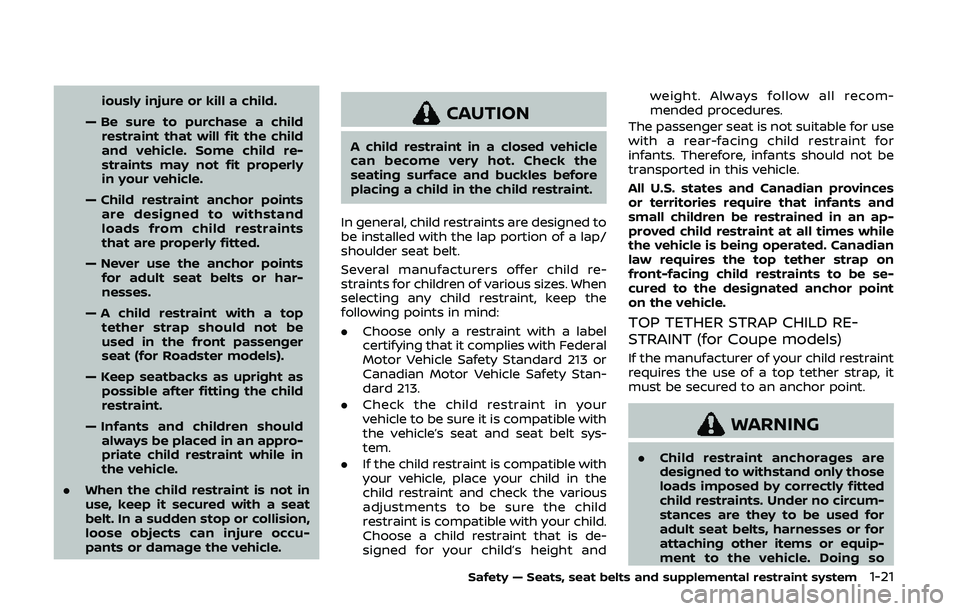
iously injure or kill a child.
— Be sure to purchase a child restraint that will fit the child
and vehicle. Some child re-
straints may not fit properly
in your vehicle.
— Child restraint anchor points are designed to withstand
loads from child restraints
that are properly fitted.
— Never use the anchor points for adult seat belts or har-
nesses.
— A child restraint with a top tether strap should not be
used in the front passenger
seat (for Roadster models).
— Keep seatbacks as upright as possible after fitting the child
restraint.
— Infants and children should always be placed in an appro-
priate child restraint while in
the vehicle.
. When the child restraint is not in
use, keep it secured with a seat
belt. In a sudden stop or collision,
loose objects can injure occu-
pants or damage the vehicle.CAUTION
A child restraint in a closed vehicle
can become very hot. Check the
seating surface and buckles before
placing a child in the child restraint.
In general, child restraints are designed to
be installed with the lap portion of a lap/
shoulder seat belt.
Several manufacturers offer child re-
straints for children of various sizes. When
selecting any child restraint, keep the
following points in mind:
. Choose only a restraint with a label
certifying that it complies with Federal
Motor Vehicle Safety Standard 213 or
Canadian Motor Vehicle Safety Stan-
dard 213.
. Check the child restraint in your
vehicle to be sure it is compatible with
the vehicle’s seat and seat belt sys-
tem.
. If the child restraint is compatible with
your vehicle, place your child in the
child restraint and check the various
adjustments to be sure the child
restraint is compatible with your child.
Choose a child restraint that is de-
signed for your child’s height and weight. Always follow all recom-
mended procedures.
The passenger seat is not suitable for use
with a rear-facing child restraint for
infants. Therefore, infants should not be
transported in this vehicle.
All U.S. states and Canadian provinces
or territories require that infants and
small children be restrained in an ap-
proved child restraint at all times while
the vehicle is being operated. Canadian
law requires the top tether strap on
front-facing child restraints to be se-
cured to the designated anchor point
on the vehicle.
TOP TETHER STRAP CHILD RE-
STRAINT (for Coupe models)
If the manufacturer of your child restraint
requires the use of a top tether strap, it
must be secured to an anchor point.
WARNING
. Child restraint anchorages are
designed to withstand only those
loads imposed by correctly fitted
child restraints. Under no circum-
stances are they to be used for
adult seat belts, harnesses or for
attaching other items or equip-
ment to the vehicle. Doing so
Safety — Seats, seat belts and supplemental restraint system1-21